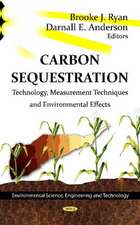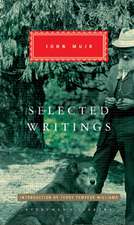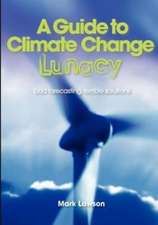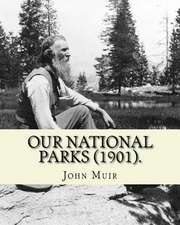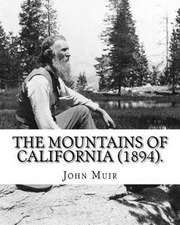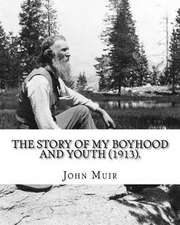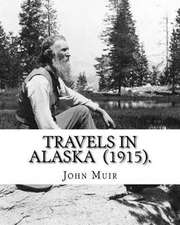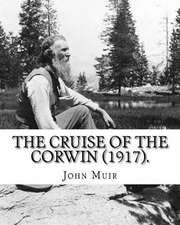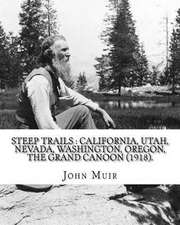Our National Parks
Autor John Muiren Limba Engleză Paperback – 30 iun 2008
| Toate formatele și edițiile | Preț | Express |
|---|---|---|
| Paperback (8) | 80.12 lei 3-5 săpt. | +14.03 lei 5-11 zile |
| Dover Publications Inc. – 30 noi 2019 | 80.12 lei 3-5 săpt. | +14.03 lei 5-11 zile |
| Vertebrate Publishing – 25 oct 2018 | 85.98 lei 3-5 săpt. | |
| University of Wisconsin Press – 15 mai 1981 | 158.22 lei 3-5 săpt. | |
| Merz Press – 29 iun 2008 | 153.24 lei 6-8 săpt. | |
| COSIMO CLASSICS – 30 noi 2006 | 169.45 lei 6-8 săpt. | |
| Pickard Press – 30 iun 2008 | 237.52 lei 38-44 zile | |
| ROSS & PERRY INC – 30 sep 2003 | 242.29 lei 6-8 săpt. | |
| Hamlin Press – 8 dec 2009 | 250.95 lei 38-44 zile | |
| Hardback (1) | 97.09 lei 3-5 săpt. | |
| Gibbs Smith – 17 iul 2018 | 97.09 lei 3-5 săpt. |
Preț: 237.52 lei
Nou
Puncte Express: 356
Preț estimativ în valută:
45.46€ • 47.28$ • 37.53£
45.46€ • 47.28$ • 37.53£
Carte tipărită la comandă
Livrare economică 10-16 aprilie
Preluare comenzi: 021 569.72.76
Specificații
ISBN-13: 9781409787365
ISBN-10: 1409787362
Pagini: 400
Dimensiuni: 140 x 216 x 23 mm
Greutate: 0.5 kg
Editura: Pickard Press
ISBN-10: 1409787362
Pagini: 400
Dimensiuni: 140 x 216 x 23 mm
Greutate: 0.5 kg
Editura: Pickard Press
Notă biografică
John Muir (April 21, 1838 - December 24, 1914) was a Scottish-American naturalist, author, environmental philosopher and early advocate of preservation of wilderness in the United States. His letters, essays, and books telling of his adventures in nature, especially in the Sierra Nevada mountains of California, have been read by millions. His activism helped to preserve the Yosemite Valley, Sequoia National Park and other wilderness areas. The Sierra Club, which he founded, is a prominent American conservation organization. The 211-mile (340 km) John Muir Trail, a hiking trail in the Sierra Nevada, was named in his honor.[2] Other such places include Muir Woods National Monument, Muir Beach, John Muir College, Mount Muir, Camp Muir and Muir Glacier. In Scotland, the John Muir Way, a 130 mile long distance route, was named in honor of him.
In his later life, Muir devoted most of his time to the preservation of the Western forests. He petitioned the U.S. Congress for the National Park bill that was passed in 1890, establishing Yosemite National Park. The spiritual quality and enthusiasm toward nature expressed in his writings inspired readers, including presidents and congressmen, to take action to help preserve large nature areas. He is today referred to as the "Father of the National Parks" and the National Park Service has produced a short documentary about his life.
Muir has been considered 'an inspiration to both Scots and Americans'. Muir's biographer, Steven J. Holmes, believes that Muir has become "one of the patron saints of twentieth-century American environmental activity," both political and recreational. As a result, his writings are commonly discussed in books and journals, and he is often quoted by nature photographers such as Ansel Adams. "Muir has profoundly shaped the very categories through which Americans understand and envision their relationships with the natural world," writes Holmes. Muir was noted for being an ecological thinker, political spokesman, and religious prophet, whose writings became a personal guide into nature for countless individuals, making his name "almost ubiquitous" in the modern environmental consciousness. According to author William Anderson, Muir exemplified "the archetype of our oneness with the earth",[ while biographer Donald Worster says he believed his mission was "...saving the American soul from total surrender to materialism.":403 On April 21, 2013, the first ever John Muir Day was celebrated in Scotland, which marked the 175th anniversary of his birth, paying homage to the conservationist.
Descriere
Descriere de la o altă ediție sau format:
Our National Parks is a guidebook supreme, an exciting introduction to Yosemite and several other magnificent parks by the man who, more than any other person, helped to create them. After this fast-paced trip with Muir, past visitors to the parks will want to revisit them with new insights, and those who have never wandered these trails will not rest until they have done so.
The book, long out of print, was originally published in 1901, its ten essays having previously appeared as articles in the Atlantic Monthly. Muir wrote them with a single purpose—to entice people, by his descriptions, to come to the parks, to see and enjoy them. If enough people did so, reasoned Muir, they would surely love the wilderness as he did, and the parks would be preserved.
Muir carried out his public relations mission with remarkable success. Every page of this book carries his unbridled and irresistible enthusiasm. Our National Parks is part reminiscence, part philosophy, and mostly enticing description. It is all vintage Muir.
Although the book treats Yellowstone, Sequoia, General Grant, and other national parks of the Western U.S., Muir devotes the bulk of the work to his first love—Yosemite, settled into the heart of the Sierra Nevada. Indeed, six of the book’s chapters are devoted to Yosemite, treating the forests, wild gardens, fountains and streams, animals, and birds of the park. The concluding essay is an impassioned plea to save American forests.
All visitors to the great western national parks—and all who will one day visit them—will be captivated by Muir’s descriptions. The grandeur of this wilderness is reflected in the very spirit of John Muir. Both shine through every page of this remarkable book.
The book, long out of print, was originally published in 1901, its ten essays having previously appeared as articles in the Atlantic Monthly. Muir wrote them with a single purpose—to entice people, by his descriptions, to come to the parks, to see and enjoy them. If enough people did so, reasoned Muir, they would surely love the wilderness as he did, and the parks would be preserved.
Muir carried out his public relations mission with remarkable success. Every page of this book carries his unbridled and irresistible enthusiasm. Our National Parks is part reminiscence, part philosophy, and mostly enticing description. It is all vintage Muir.
Although the book treats Yellowstone, Sequoia, General Grant, and other national parks of the Western U.S., Muir devotes the bulk of the work to his first love—Yosemite, settled into the heart of the Sierra Nevada. Indeed, six of the book’s chapters are devoted to Yosemite, treating the forests, wild gardens, fountains and streams, animals, and birds of the park. The concluding essay is an impassioned plea to save American forests.
All visitors to the great western national parks—and all who will one day visit them—will be captivated by Muir’s descriptions. The grandeur of this wilderness is reflected in the very spirit of John Muir. Both shine through every page of this remarkable book.












